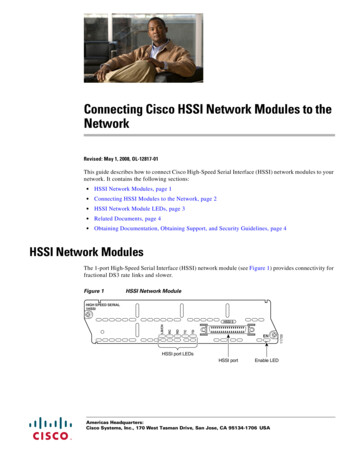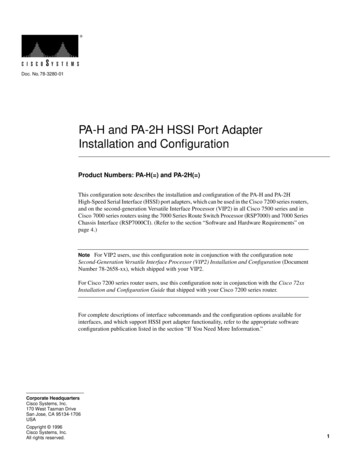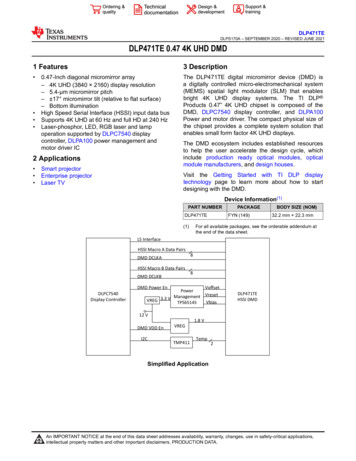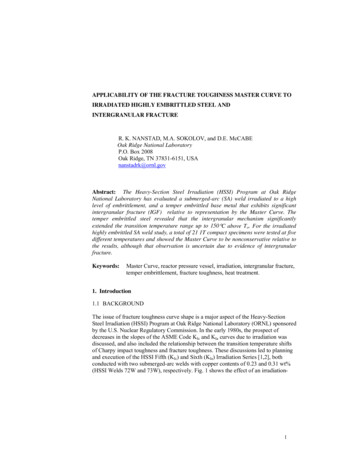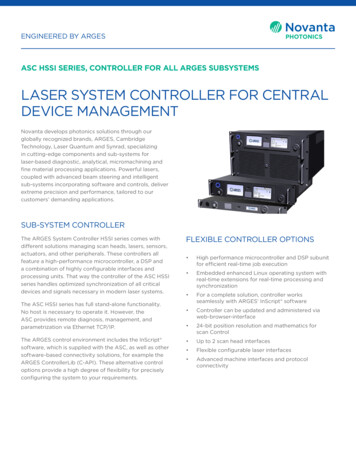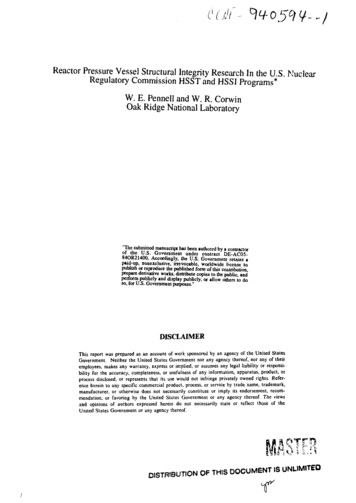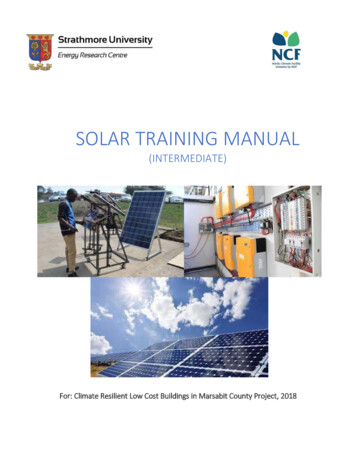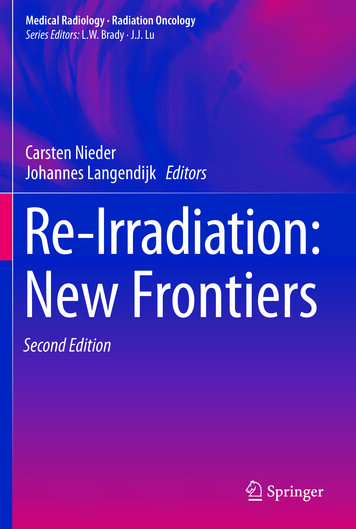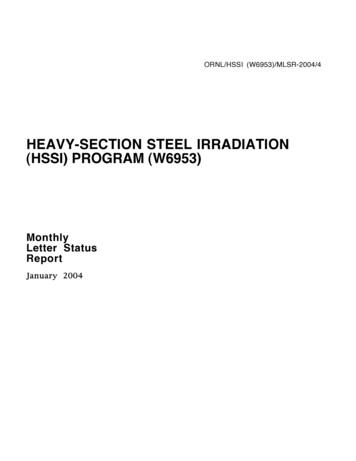
Transcription
ORNL/HSSI (W6953)/MLSR-2004/4HEAVY-SECTION STEEL IRRADIATION(HSSI) PROGRAM (W6953)MonthlyLetter StatusReportJanuary 2004
DOCUMENT AVAILABILITYReports produced after January 1, 1996, are generally available free via the U.S. Department ofEnergy (DOE) Information Bridge.Web site http://www.osti.gov/bridgeReports produced before January 1, 1996, may be purchased by members of the public from thefollowing source.National Technical Information Service5285 Port Royal RoadSpringfield, VA 22161Telephone 703-605-6000 (1-800-553-6847)Internal Use OnlyTDD 703-487-4639Fax 703-605-6900This documenthas not been given final patent clearance and is for internal use only.E-mail info@ntis.fedworld.govIf this documentis to be given public release, it must be cleared through the siteWebInformationsite icalOffice which will see that the proper patent and technicalinformation reviews are completed in accordance with UT-Battelle Policy.Reports are available to DOE employees, DOE contractors, Energy Technology Data Exchange(ETDE) representatives, and International Nuclear Information System (INIS) representativesfrom the following source.Office of Scientific and Technical InformationP.O. Box 62Oak Ridge, TN 37831Telephone 865-576-8401Fax 865-576-5728E-mail reports@adonis.osti.govWeb site http://www.osti.gov/contact.htmlThis report was prepared as an account of work sponsored byan agency of the United States Government. Neither theUnited States Government nor any agency thereof, nor any oftheir employees, makes any warranty, express or implied, orassumes any legal liability or responsibility for the accuracy,completeness, or usefulness of any information, apparatus,product, or process disclosed, or represents that its usewould not infringe privately owned rights. Reference hereinto any specific commercial product, process, or service bytrade name, trademark, manufacturer, or otherwise, does notnecessarily constitute or imply its endorsement,recommendation, or favoring by the United StatesGovernment or any agency thereof. The views and opinions ofauthors expressed herein do not necessarily state or reflectthose of the United States Government or any agency thereof.
ORNL/HSSI (W6953)/MLSR-2004/4HEAVY-SECTION STEEL IRRADIATIONPROGRAMJCN W6953MONTHLY LETTER STATUS REPORTFORJanuary 2004Submitted byT. M. RosseelHSSI Project ManagerCompiled byP. J. HadleySubmitted toC. J. FairbanksNRC Project ManagerOAK RIDGE NATIONAL LABORATORYOak Ridge, Tennessee 37831managed byUT-Battelle, LLC.for theU. S. DEPARTMENT OF ENERGYUnder DOE Contract No. DE-AC05-00OR22725
Internal Use OnlyThis document has not been given final patent clearance and is for internal use only.If this document is to be given public release, it must be cleared through the siteTechnical Information Office which will see that the proper patent and technicalinformation reviews are completed in accordance with UT-Battelle Policy.
PREFACEThis report is issued monthly by the staff of the Heavy-Section Steel Irradiation (HSSI)Program (JCN:W6953) to provide the Nuclear Regulatory Commission (NRC) staff withsummaries of technical highlights, important issues, and financial and milestone status withinthe program.This report gives information on several topics corresponding to events during thereporting month: (1) overall project objective, (2) technical activities, (3) meetings and trips, (4)publications and presentations, (5) property acquired, (6) problem areas, and (7) plans for thenext reporting period. Next the report gives a breakdown of overall program costs as well ascost summaries and earned-value-based estimates for performance for the total program and foreach of the six program tasks. The six tasks, including a project management task, correspondto the 189, dated August 29, 2003. The final part of the report provides financial status for alltasks and status reports for selected milestones within each task. The task milestones addressthe period from October 2003 to July 2005, while the individual task budgets address the periodfrom October 2002 to December 2003.Beginning in October 1992, the monthly business calendar of the Oak Ridge NationalLaboratory was changed and no longer coincides with the Gregorian/Julian calendar. Thebusiness month now ends earlier than the last day of the calendar month to allow adequate timefor processing required financial reports to the Department of Energy. The precise reportingperiod for each month is indicated on the financial and milestone charts by including the exactstart and finish dates for the current business month.Thomas M. Rosseel, ManagerHeavy-Section Steel IrradiationProgram
MONTHLY LETTER STATUS REPORTJanuary 2004Job Code Number:Project Title:Period of Performance:Performing Organization:Program -Section Steel Irradiation Program4/1/98 to 12/31/05Oak Ridge National LaboratoryT. M. RosseelP.O. Box 2008Oak Ridge, Tennessee 37831-6161(865) 574-5380(865) 574-6095rosseeltm@ornl.gov1. PROJECT OBJECTIVE:The primary goal of the Heavy-Section Steel Irradiation (HSSI) Program is to provide athorough, quantitative assessment of the effects of neutron irradiation on the material behavior,and in particular the fracture toughness properties, of typical pressure vessel steels as they relateto light-water reactor pressure vessel (RPV) integrity. The program includes studies of theeffects of irradiation on the degradation of mechanical and fracture properties of vesselmaterials\ augmented by enhanced examinations and modeling of the accompanyingmicrostructural changes. Effects of specimen size; material chemistry; product form andmicrostructure; irradiation fluence, flux, temperature, and spectrum; and post-irradiationmitigation are being examined on a wide range of fracture properties. This program will alsomaintain and upgrade computerized databases, calculational procedures, and standards relating toRPV fluence-spectra determinations and embrittlement assessments. Results from the HSSIstudies will be incorporated into codes and standards directly applicable to resolving majorregulatory issues that involve RPV irradiation embrittlement such as pressurized-thermal shock,operating pressure-temperature limits, low-temperature overpressurization, and the specializedproblems associated with low upper-shelf welds. Five technical tasks and one for programmanagement are now contained in the HSSI Program.2. TECHNICAL ACTIVITIES:TASK 1: Program Management (T. M. Rosseel)This task is responsible for managing the program to ensure that the overall objectives areachieved. The management responsibilities include three major activities: (1) program planningand resource allocation; (2) program monitoring and control; and (3) documentation andtechnology transfer. Program planning and resource allocation includes: (a) developing andpreparing annual budgetary proposals and (b) issuing and administrating subcontracts to othercontractors and consultants for specialized talents not available at Oak Ridge National
Laboratory (ORNL) or that supplement those at ORNL. Program monitoring and controlincludes: (a) monitoring and controlling the project through an earned-value, projectmanagement system; (b) ensuring that quality assurance (QA) requirements are satisfied; and (c)issuing monthly management reports. Documentation and technology transfer includes: (a)participating in appropriate codes and standards committees; (b) preparing briefings for theNRC; (c) coordinating NRC and internal ORNL review activities; (d) coordinating domestic andforeign information exchanges approved by NRC; and (e) documenting the activities of theprogram through letter and NUREG reports.(Milestone 1.1.B) During this reporting period, discussions with the staff of the University ofMichigan Ford Nuclear Reactor (FNR) continued concerning removal of specimens, return ofcontrol panels and disposal of irradiated waste. (See Task 6 for details).(Milestone 1.3.C) Planning for reactor site evaluations for future irradiation experiments, incooperation with the DOE Gen IV Program, continued during this reporting period.The proposed site evaluation of the University of Missouri, 10 MW Missouri UniversityResearch Reactor (MURR) in Columbia, Missouri was rescheduled from January 27 untilFebruary 3, due to weather conditions.The proposed site evaluation of the Massachusetts Institute of Technology (MIT), 4.9 MWMITR II tank-type reactor has been rescheduled for the third week of February to accommodateORNL staff schedule changes.In cooperation with the DOE Gen IV Materials Program, planning for March site visits andevaluations of three European reactors: (1) the LV-15 reactor at the Nuclear Research Institute(NRI), Rez, Czech Republic, Dr. Milan Brumovsky, point of contact; (2) the BR2 reactor atSCK, Mol, Belgium, Dr. Eric van Walle, point of contact; and (3) the R2(0) reactor at StudsvikNuclear, Studsvik, Sweden, Dr. Mikael Karlsson, point of contact, has begun. Target dates forthe visits are March 19 – March 30.On January 11-13, R. K. Nanstad, T. M. Rosseel, and M. A. Sokolov traveled to Tampa Fl, toparticipate in the ASTM E10.02 Committee meeting. The principle focus of the discussions wasthe evaluation of the quality and uniqueness of the data supplied by the industry representativesat the June 2003, Denver ASTM Committee meeting for use in the predictive embrittlementequations.Task 2: Fracture Toughness Transition and Master Curve Methodology (M. A. Sokolov)Fracture-toughness transition and master-curve (MC) methodology will be broadly explored forpressure-vessel applications through a series of experiments, analyses, and evaluations in eightSubtasks. The effects of irradiation on fracture-toughness curve shape for highly embrittled RPVsteels, dynamic effects, crack arrest, intergranular fracture, and subsized specimens will also beexplored. Additionally, the fluence received in the HSSI irradiation experiments will bedetermined.
Subtask 2.1: Fracture Toughness Transition Temperature Shifts (M. A. Sokolov)The purpose of this subtask is to collect and statistically analyze pertinent fracture-toughnessdata to assess the shift and potential change in shape of the fracture-toughness curves due toneutron irradiation. The MC methodology will be applied to provide a statistical analysis of thefracture-toughness data and Charpy data will be fitted by hyperbolic tangent function. Theresulting reference fracture-toughness temperature, To, shifts are compared with Charpy shiftsdetermined by various indexing methods.(Milestone 2.1.A) The report by M. A. Sokolov and R. K. Nanstad, Comparison of IrradiationInduced Shifts of KJc and Charpy Impact Toughness for Reactor Pressure Vessel Steels,NUREG/CR-6609 (ORNL/TM-13755), was published by the NRC in November 2000. Therewas no significant progress during this reporting period. However, as they become available,additional data sets will be analyzed and a revised database assembled.Subtask 2.2: Fracture Toughness Characterization of Highly Embrittled Materials (M. A.Sokolov)The purpose of this subtask is to evaluate the assumption of constant shape for the MC for highlyembrittled RPV steels and to determine the effect of the interaction of low-energy ductile crackinitiation with cleavage in the transition region for highly embrittled materials. The evaluationwill be performed through the testing of pressure-vessel steels that have been irradiated to aneutron fluence sufficient to produce a fracture-toughness transition-temperature shift (To) ofabout 150 C (270 F). Other materials to be irradiated and examined for the curve shape effectsstudy include a highly embrittled low upper-shelf RPV steel that exhibits onset of stable ductiletearing at relatively low fracture toughness and a high-nickel weld.(1) A specially fabricated, radiation-sensitive, weld was selected to perform a pilot study on theability of a highly embrittled material to maintain the master-curve shape. This weld, which wasfabricated and studied in Germany, was supplied to ORNL by MPA, Stuttgart through aMemorandum of Agreement (MOA). Capsules, loaded with 21 1T compact specimens and alarger number of smaller specimens of Weld KS-01, were irradiated to a target fluence of8.0!x!1018 n/cm2 at the FNR during the first HSSI-IAR irradiation campaign. Evaluation of thefracture-toughness transition curve shape has been performed with 1T compact specimens, 1TC(T). Additionally, 0.5T C(T), and pre-cracked Charpy V-notch (PCVN) specimens were testedto investigate the use of more practical surveillance-size specimens. Tensile specimen testingwas also completed to determine the irradiation-induced hardening. Evaluation of themechanical properties of the unirradiated weld has been completed. Sixteen 0.4T C(T)specimens from the previously irradiated and tested KS01 1T C(T) specimens will be preparedand tested for fracture toughness. These data will be compared with results from small and largecompact specimens as well as pre-cracked Charpy specimens from the same material in theunirradiated and irradiated conditions.(2) Specimens of the Midland belt line weld were fabricated and placed into the IAR facility atthe FNR for irradiation to a fluence of at least 3 x 1019 n/cm2 ( 1 MeV). This irradiation is being
conducted to evaluate the assumption of constant shape for the master curve with highlyembrittled low upper-shelf RPV steels that exhibit onset of stable ductile tearing at relatively lowfracture toughness.(3) A high nickel weld from the Palisades steam generator will also be examined. Not only willthis material provide additional information on curve shape effects, it will permit experimentalvalidation of an assumption of 1:1 relationship between Charpy 41J and fracture toughness shiftsfor highly embrittled materials. Eight 0.5C(T) and twelve Charpy specimens were irradiated tothe intermediate fluence of 1.6x1019 n/cm2 ( 1 MeV) and these specimens shall be tested. Theseresults will be compared to the small specimens data from the UCSB program where this weldwas also characterized after a similar dose of irradiation.(Milestone 2.2.A) Irradiation of the Midland beltline weld and a high-nickel weld from thePalisades steam generator has been completed with shutdown of the University of MichiganFNR on July 3, 2003. Following an appropriate cool-down period, the specimens will beremoved from the IAR facility and shipped to the ORNL hot cells for testing. Please also seeTask 6.2.(Milestone 2.2.B) Some of the Palisades steam generator specimens irradiated to an intermediatefluence were removed previously and were received at the ORNL hot cells. These specimenswere sorted and identified in preparation for testing, as discussed below (Milestone 2.2.G).(Milestone 2.2.C) As reported previously, programming of the computer numerically controlled(CNC) milling machine system and the design of fixtures has been completed. Preparations formachining of the 0.4T!compact specimens from the broken irradiated 1T compact specimens ofKS-01 is under way with evaluation of the CNC machine operational status, design andfabrication of special fixtures for remote change-out of tools, remote lubrication of moving parts,etc. The machine has been exercised, various issues have been identified, and the issues arebeing resolved. A number of practice specimens have been machined and measured forcomparison with established tolerances. This practice machining has identified a number ofissues relevant to machining of compact specimens and the issues have been largely resolved,including the machining of new specimen holder fixtures from steel, as opposed to aluminum.Following machining of the irradiated specimens, these 0.4T specimens will be tested in thesame general temperature range as the 1Ts described in Task 2.2 to expand the database furtherfor this material, and will provide for a comparison of compact specimen results with those fromthe similar size pre-cracked Charpy specimens. This comparison is directed at the bias indicatedin some precracked Charpy data that results in somewhat lower determinations of To relative tocompact specimens.(Milestone 2.2.D) As noted previously, 21 1T and six additional 0.5T compact specimens of thesubmerged-arc weld KS-01, irradiated to 0.8 !1019 n/cm2 ( 1 MeV), were successfully tested.The results have been evaluated relative to the shape of the master curve. The occurrence ofintergranular fracture in the test specimens was suspected to influence the deviation from MCshape observed. However, for a number of reasons also discussed previously, the contribution ofIGF is not clear and the nonconformance of the KS-01 irradiated fracture toughness data may be
predominantly due to the high degree of irradiation embrittlement. Further statistical analysis hasbeen performed with these data and have been included in the draft NUREG report. Threeadditional tensile tests, as noted previously, were expected to shed light on the effects of theintergranular fracture observations relative to expected irradiation-induced hardening. The yieldand ultimate strengths for these tests exhibited the expected irradiation-induced strengthening,indicating that intergranular fracture was not the dominant fracture mechanism.Testing of 12 irradiated precracked Charpy KS-01 specimens has been completed and the resultshave been analyzed. The draft NUREG report has completed technical review and incorporationof the reviewers’ comments, and was submitted to the NRC for publication in December. TheKS-01 results were also included in a presentation on nickel effects at the IGRDM-11 meeting inSan Diego in September. Please see Section 4.(Milestone 2.2.G) Charpy impact tests of the Palisades unirradiated specimens and specimensirradiated to 1.38! !1019!n/cm2 ( 1 MeV) were performed. The material exhibited a Charpy41-J shift of 101ºC. Using the assumed fluence, this is considerably less than the predicted shiftof 148ºC by Regulatory Guide!1.99 (Rev. 2) and the predicted shift of 137ºC by the Eason,Wright, Odette (EWO) equation. Both predictions are, of course, dependent on the chemicalcomposition variables used. The chemical composition used was an average of values availablefor the weld. Additional analyses will be conducted with the tested specimens to verify thosevalues and will be compared with subsequent results from testing of the specimens irradiated to ahigher fluence when they become available.One broken half of a tested CVN specimen was submitted for atom-probe needle preparation.The fracture surface was cut from the specimen and a 0.5-mm-thick slice was cut from theremainder of the specimen. That slice was then cut into 0.5-mm-thick blanks with approximatedimensions of 0.5! !0.5! !10!mm. The blanks were stored in a lead pig and transported to theatom probe preparation facility. Atom probe needles were prepared and atom probe tomography(APT) was conducted. The APT examinations revealed copper-enriched precipitates alsoenriched with manganese and nickel. This result was also incorporated into the presentation onnickel effects at the IGRDM-11 meeting in San Diego in September.Additional testing of the Palisades weld will be conducted following reception of the highfluence specimens from the FNR. Charpy V-notch tests will be performed followed by cutting ofatom probe needles for atom probe tomography examination.Subtask 2.3: Dynamic Fracture Toughness (R. K. Nanstad, post doc)The purpose of this subtask is to evaluate the applicability of the MC to dynamic fracturetoughness of RPV steels. There are data available that suggest reasonable applicability of themaster curve to dynamic fracture toughness data; however, a review of the available data underhigh-rate loading conditions is needed. There are also data available that indicate a significanteffect of loading rate within the limits prescribed in ASTM E1921. Previous plans within theHSSI Program included the evaluation of data from precracked Charpy specimens tested underimpact conditions. Although the development of such techniques and resulting data aredesirable, the first recommended step in evaluation of the master curve will be a review of the
available data mentioned above. The conduct of high-rate loading experiments under elasticplastic conditions with compact specimens under non-impact conditions will be dependent on theresults of that review.(Milestone 2.3.A and 2.3.B) If the review discussed above results in a recommendation foradditional testing, compact specimens (either 0.5T or 1.0T) will be machined from a materialwith a Master Curve pedigree, such as HSST Plate 02, HSST Plate 13A, or HSSI Welds72W/73W, and tested at a rate consistent with the dynamic elastic-plastic fracture toughnessannex in ASTM E-1820-2001. This will allow for a direct comparison between To from quasistatic and dynamic tests. As mentioned above, a variation of loading rates within the E-1921allowable range will also be considered following a review of the recently recommendedchanges regarding loading rates in the E-1921 standard. This issue has been identified as apotential area of investigation in a proposed Cooperative Research Program at the InternationalAtomic Energy Agency (IAEA). Additionally, a review of instrumented impact testing ofprecracked Charpy specimens will be conducted to assess the potential inclusion of thattechnique in the project.Subtask 2.4: Intergranular Fracture (R. K. Nanstad)This subtask will address the issue of whether the MC technique can be applied to materials thatexperience brittle fracture by an intergranular mechanism. Specifically, it will be determinedwhether steels that experience intergranular fracture can be correctly characterized by the MC Totemperature and whether the transition-curve shape can be changed by different fracture modes.Complete intergranular fracture from temper embrittlement occurs only at lower-shelftemperatures. As it is with transgranular cleavage, the transition to upper shelf is marked by anincreased volume percentage of ductile rupture mixed with the lower-shelf, brittle-fracturemechanism. Since the onset of crack instability is most likely triggered in the brittle zones, thecritical issue becomes one of understanding the influence of the triggering mechanism on thedistribution of KJc values obtained. This information can be obtained on the lower shelf and, inpart, into the transition range.The proposed approach is to determine if there is an operational weakest-link effect wheninstability is triggered within an intergranular region. If an effect is observed, there should alsobe a measurable specimen-size effect on KJc. It will also be determined if the temper-embrittledmaterials exhibit a change in the J-R fracture toughness since such steels do not show asignificant change in upper-shelf CVN energy.The modified A302 grade B steel selected to evaluate intergranular-fracture effects on theuniversal MC shape assumption was specially heat treated to temper embrittle the material, andfracture-toughness testing was performed. In the analysis of the data, however, it became clearthat additional testing was deemed necessary to allow for a more definitive conclusion regardingthe relationship between the intergranular fracture results and the Master Curve. A letter reportdescribing this work was submitted in December 2002.
Additional 0.5TC(T) specimens were fabricated and tested, demonstrating that materials that failwith 100% intergranular fracture are not appropriate for MC characterization. This resultcompares with observations of materials that have failed with 10 to 20% intergranular fractureand which appear to behave in a manner consistent with MC characterization.(Milestone 2.4.A) A test plan for intergranular fracture (IGF) assessment for conditions thatproduce less than 100% IGF is being developed.Subtask 2.5: Sub-sized Specimens (M. A. Sokolov, guest/post doc)The purpose of this subtask is to evaluate the applicability of the weakest-link theory-based sizeadjustment procedure in the MC methodology to specimen sizes that are the most likely to bepresent in surveillance capsules. The MC methodology will be applied using precrackedCharpy-size or smaller specimens to test the lower-size limit applicability. Testing will beperformed at two or more temperatures with at least six specimens at each temperature. Theexact number of temperatures and specimens will be determined following analysis of initialresults. The testing of these subsize specimens will also satisfy the HSSI Program test matrixwithin the New Coordinated Research Program (CRP) of the International Atomic EnergyAgency (IAEA).(Milestone 2.5.A) As reported previously, the testing and analysis of specimens has beencompleted. These specimens were machined from three blocks of materials into 1TC(T) andprecracked Charpy specimens for the size effect study. Two of the blocks are broken halves of4TC(T) specimens of two A302B plates previously tested by the HSSI Program. The third blockof material is the well-characterized Plate 13A. This study is specifically designed as anevaluation of the precracked Charpy specimen.(Milestone 2.5.B) A series of subsize specimens of JRQ steel has also been completed. Thespecimens are 0.2TC(T) and 0.4TC(T), and 5!by!5 mm and 5!by!10 mm SE(B) specimens.(Milestone 2.5.C) Preparation of the draft letter report has continued during this reporting period.It is anticipated that the report will be submitted for review as well as published and distributedduring the next reporting period.Subtask 2.6: Dosimetry and Fluence Analysis of the IAR Irradiation Capsules (C. A. Baldwin, I.Remec, and T. M. Rosseel)The purpose of this task is to measure and analyze the dosimeters used during the HSSI-IARirradiation campaigns and to obtain accurate fluence determinations.(Milestone 2.6.A) As reported previously, the set of four Fissionable Radiometric Dosimeters(FRDs), removed from the IAR facilities in April 2001, and shipped to counting lab, will be usedto verify the fluence estimates for the high-Nickel specimens and re-irradiation specimensremoved from the FNR in 2001.
(Milestone 2.6.C) – (I. Remec and E. D. Blakeman) Final conversion of the LSL-M2 codepackage from DOS to Linux will be completed during the second quarter of the new fiscal year.A report, previously prepared under JCN 6164, will be issued as an ORNL technical report.The report entitled, Characterization of the Neutron Field in the HSSI/UCSB Irradiation Facilityat the Ford Nuclear Reactor, by I. Remec, E. D. Blakeman, and C. A. Baldwin, NUREG/CR6646 (ORNL/TM-1999/140) was submitted to the NRC in September 1999.Subtask 2.7: Investigate the Bias Term Added to To Values Determined from Pre-CrackedCharpy Specimens (R. K. Nanstad)The purpose of this task is to perform a systematic study of the bias term added to To valuesdetermined from pre-cracked Charpy specimens, such as that used in the Kewaunee evaluation.The approach would utilize both analytical and experimental methods. Either HSST Plate 02 orHSST Plate 13A will be used since extensive C(T) data on these materials are available.(Milestone 2.7.A) Planning for this task has continued. The experimental phase of the bias termproject will tentatively include 1T three-point bend specimens, precracked Charpy specimenswith and without side-grooves, Charpy thickness [10 mm (0.394 in.)] compact specimens, somewith the standard ligament and some with half the standard ligament to provide a directcomparison with the precracked Charpy specimen. The issue of two different materials is alsounder consideration. HSST Plate 13A is one material of choice because of the extensivecompact specimen-derived fracture toughness database available for that material. One importantaspect of such testing is the number of specimens needed to provide a statistically reliableestimate of the difference in To for each specimen geometry. There are various methods for sucha calculation that will not be discussed here. However, if one desires to know To within 10 C( 2 standard deviations) using the equation provided in E1921, the number of specimens neededis 13. If a two standard deviations variation of 5 C is desired, the number of specimens neededis 52. Thus, statistical considerations will play a strong role in the test matrix. The draft will bediscussed with appropriate and interested reviewers outside of ORNL. R. K. Nanstad visitedSCK-CEN, Mol, Belgium, in September and discussed this issue with Eric Van Walle and hisstaff. Additionally, presentations and discussions from the ASTM E-08 Workshop on Constraintare being evaluated relative to planning of the experimental and analytical needs. A literaturereview is in progress, including a review of linear elastic fracture mechanics (LEFM) results thatmay provide information regarding specimen configuration differences observed as the result ofspecimen fractures under predominantly elastic loading. The use of the T-stress based constraintadjustments have received considerable discussions within the technical community and acomparison of such LEFM data may shed light on that specific subject.Subtask 2.8: Verify the 72W To Value (R. K. Nanstad)The purpose of this subtask is to verify the To value for HSSI weld 72W. The ASME MaterialsProperties Council conducted a round robin testing program a few years ago with pre-crackedCharpy specimens of two RPV steels, one of which was HSSI Weld 72W. The specimens weremachined from the "second batch" of weld 72W. The results showed a disparity in the To valuesof about 20ºC between that determined from the pre-cracked Charpy specimens and that from theextensive base of fracture toughness data using the "first batch" of 72W.
(Milestone 2.8.A) A block of HSSI Weld 72W (second batch) was located, drawings wereprepared, and 13 1T compact specimens were machined, fa
ORNL/HSSI (W6953)/MLSR-2004/4 HEAVY-SECTION STEEL IRRADIATION PROGRAM JCN W6953 MONTHLY LETTER STATUS REPORT FOR January 2004 Submitted by T. M. Rosseel HSSI Project Manager Compiled by P. J. Hadley Submitted to C. J. Fairbanks NRC Project Manager OAK RIDGE NATIONAL LABORATORY Oak Ridge, Tennessee 37831 managed by UT-Battelle, LLC. for the U. S .
